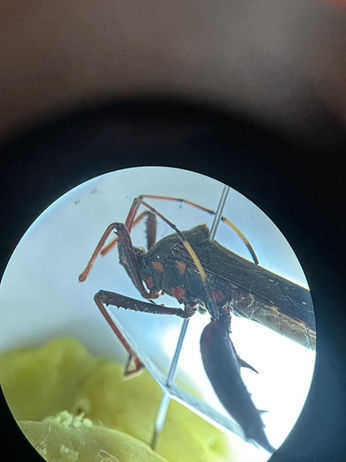
Summer Undergraduate International Research Experience

.png)
Week 2
-
This week was spent taking tons of pictures of interesting bugs, in hopes to measure their spines and femurs. The insect in the first picture is unindentified- I suspect it might be a new species because of the lack of visual matches or written descriptions that match it. This week I also visited for the first time the University's hemipteran collection- It is kept in a camphor-smelling, temperature and humidity controlled room that houses insects starting from the 1950's. I was surprised to learn that collection was started by Father Moure, who also funded the Department of Zoology at UFPR. Moure was an entomologist who was very passionate about bees, which was evident in the size of the Hymenopteran collection. He paid dozens of entomologists to collect and bring to the University insect specimens from all over the country and the world. The collection now has close to seven million insects, and over 600 holotypes! My favorite insects I saw there were the Membracids, in the fourth picture.
As it neared the end of the week, we came upon a holiday, which are taken seriously by brazilians. I was out of the lab from Thursday to Sunday, and during that time I explored a few different spots in the city- notably Downtown Curitiba and the 24 hour street, a famous touristic destination in the city. On Saturday it was my mentor's wife's birthday, which was celebrated as an Arraia, a party originated in the North of the country with characteristic foods such as cooked corn, hominy, hot dogs, and many other foods.
The EvoMorfo lab
This week was a week of getting used to the lab and everything I will be doing for the following nine weeks. I have been identifying bugs to poll the number of species that will be used in my project here. Keying is a big task taken that it seems not a lot of people are interested in making keys for regular old hemipteran that are not disease vectors or agricultural epsts (bummer). I got to see the University's big insect collection, and I was given a tour by Dr. Andressa Paladini, the one responsible for the Hemipteran portion of the collection. She explained to me that her work has to do mainly with systematics of leaf-hoppers. I saw all types of incredible insects, which reminded me that I was in fact in the tropics. The insects are soniderably larger and more colorful- and more beautiful too. I saw insects I had only seen before in textbook pictures, which felt amazing. These insects were collected by people who at large were not alive anymore. Some specimens were as old as 70 years.
On Saturday I got to go out with my lab for the first time. The lab is made up of: Mariana, who is doing a project on the antennal dilatation in Coreidae, Tiago, who is studying the palmar crest of Aegla, Nathan, who studies the sexual dimorphism of Aeglas, and Joao, who does analysis of mechanical and structural properties of the Aegla chelipod. Luddy is a PhD student looking at testing eco-evolutionary models of animal contests using UFC data, and Isabella, situated in Sao Paulo, is studying change in Aegla chelipods throughout development. It was really fun to see and understand the lab dynamics right in front of my eyes, seeing the lab members interact and have fun. It was a lovely end of the day, with a little sun to offset the cold breeze. Children of professors were playing in the playground while the adults drank too many beers and got lost in conversation. I met Alexandre's sister-in-law, who works at a non-profit organization that taken in rescue cats and rehabilitates them until they are adopted. Tiago, one of the undergraduate's of the lab, brought eyeliner, and I convinced him to apply it on all the boys at the lab, Alexandre included. The party was a fun way to end the week and prepare for the next one.










